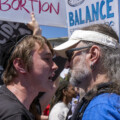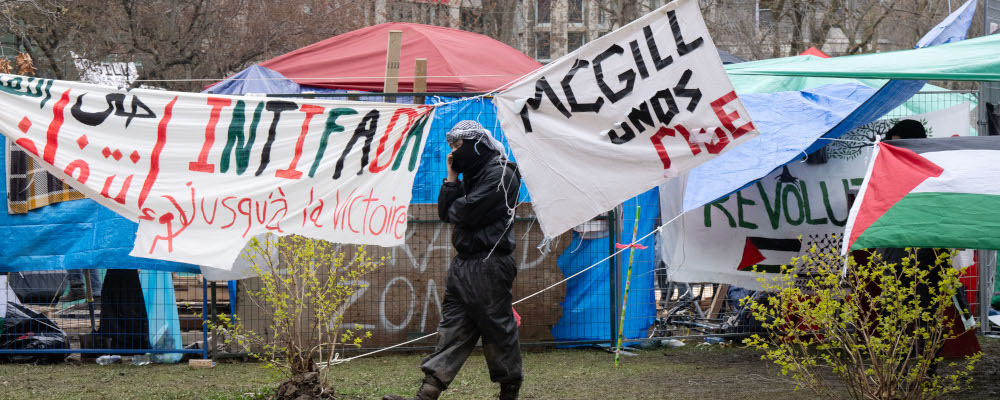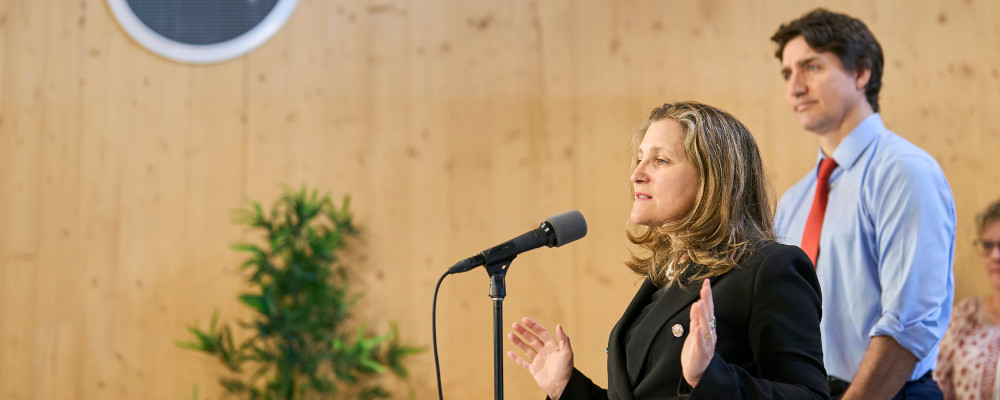The campus protest movement demanding university divestment from all things Israel and denouncing what they define as Israeli “colonialism” and “genocide” in Gaza is spreading out and digging in in the form of encampments across Canada.
University administrations and police are demonstrating a great deal of confusion around who these protestors are and ultimately how best to respond, leaving students and surrounding communities in the lurch. They are providing the opportunity for protests to devolve from more peaceful gatherings to hotbeds of antisemitic rage.
Who are the protestors?
Taking its inspiration from the United States, encampments began at McGill University in Montréal and have since fanned out across the University of Toronto and the University of Ottawa to the University of Calgary and the University of Alberta in Edmonton before boomeranging back to Quebec, most recently to Sherbrooke University.
The campus protest movement is the reciprocal, mirror image of the Freedom Convoy: a multilayered social movement shaped like an inverted pyramid. At the wide top of this inverted pyramid, you can find participants who are ordinary people there to make controversial and potentially offensive points but are nevertheless entirely legal.
At the convoy, this included the many thousands of Canadians who lined the country’s major highways to wave their support to passing trucks barrelling down to Ottawa. It also included the many thousands more who came to Ottawa itself on weekends to make a point about the damage done to their businesses and children’s development by what they viewed as draconian pandemic lockdowns. It included some vaccine skeptics who did not accept that the COVID-19 jabs had been scientifically vetted. And many more just came because they were curious or wanted to vent their hatred of Prime Minister Justin Trudeau. These groups annoyed and frightened many Ottawans who saw them as the pox of American-style politics and right-wing extremism infesting their neighbourhoods. However, these people were not breaking the law.

In the context of pro-Palestine, anti-Israel encampments, this wide layer of controversial but ultimately law-abiding protesters includes hundreds of students across the country who are horrified by the civilian deaths in Gaza from the Israel-Hamas war and are generally anti-authoritarian. While many Canadians may regard their positions as uninformed or naïve and extremely offensive, what they have come to express is not illegal.
Last Saturday, I visited the University of Ottawa campus, where I also work as a professor. I witnessed lots of these people filling the lawns in front of Tabaret Hall, hanging signs referencing groups in solidarity with Palestine.
The extreme Left’s more recent drive to universalize every perceived struggle was on full display. A group advocating for “disability justice” had hung a pamphlet persuading passersby that “Disability oppression is intertwined with Israel’s settler-colonial project in Palestine.” They added that “Israeli officials refuse to distribute COVID-19 vaccines in the West Bank and Gaza Strip.”
There was also a placard hung by a “Trans Gay Jew against genocide.” Many more signs compared the struggle of Palestinians with Indigenous groups in Canada and around the world: “The ongoing genocide in Palestine mirrors the settler colonial project across Turtle Island [Canada] and the globe.”
While documenting the signs, I was approached amiably by a bearded man wearing a reflective safety vest who appeared to be in his late 30s and who identified himself as a volunteer. He asked if I had any questions about the protest. After telling him that I was a professor at the university who often writes on protests, he encouraged me to carry on reading the signs. “You’ll see we have a total diversity of the Left represented here,” he boasted, unironically.
Beyond the now familiar slogan of “From the river to the sea” chalked onto the building steps, one sign I found that many might consider to be speech excluding Jewish students from being welcome on campus was a sign exhorting the reader to “Teach your kids” that “the Zionist entity is an enemy,” such that “resistance is an honour,” and that “there is no country called Israel.” Offensive to many, without a doubt. Yet unlikely to yield any conviction for criminally prohibited speech involving the incitement or promotion of hatred, however, as the message is directed at political entities and movements, rather than “identifiable groups” (i.e., Jews specifically), and resistance does not necessarily mean violence.
Back to our upside-down pyramid analogy, travelling to its narrow tip is a smaller number of people who begin to cross the line into criminal speech and conduct.
At the Freedom Convoy protests, this consisted of a smaller number of protesters —perhaps five or six hundred—who bedded down in the streets of Ottawa continuously for over three weeks. They basically rendered downtown unlivable (especially for those with visual impairments and other health issues) by violating court orders to cease endless horn honking and rendering public transit inoperable in the city’s core. This tip of the pyramid also consisted of protestors attempting to block economically critical border crossings into the United States, such as the Ambassador Bridge in Windsor. Counted among them were also those who brought—or were planning to bring—guns to the Coutts, Alberta border blockade.
Inside the university encampments, these are garden-variety antisemites engaging in speech that constitutes the incitement or promotion of hatred or hate-motivated forms of criminal mischief and intimidation. A key example here would be reports of a Jewish professor at the University of Toronto who was prevented by protestors from accessing encampment space based on being a member of an “identifiable group.” It would also include any forms of communication that single out Jewish people as members of any form of mysterious, powerful global cabal deserving of punishment or reprisal. It could also include caricatures of Jews appearing inhuman or animalistic.
At the encampments, it has been alleged by university administrators that this group is mostly made up of non-students who have moved onto campus, spoiling for any fight they can find. At the University of Calgary and the University of Alberta, administrators justified their swift and strict security and policing response based on their claims of growing numbers of outside agitators who posed a risk to the safety of campus communities.
While these numbers are yet to be confirmed, the major lesson of the Freedom Convoy and other mass protests is that the weight of the layers in a protest pyramid shifts over time: the majority of protestors whose actions are often “awful but lawful” become led by or driven out by a growing violent, law-breaking minority that becomes emboldened, colonizing the crowd. Overall, it is the responsibility of the police and other authorities to stop this process and keep the protests’ legal status for as long as possible.
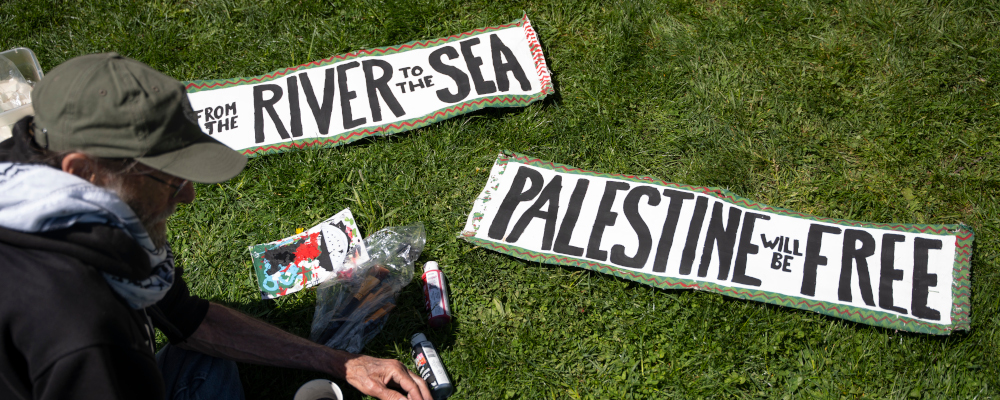
Are universities constrained by the Charter?
As was the case with the Freedom Convoy, our security responses to the campus encampment protests have been wildly different across the country on the basis of legal frameworks that are out-of-date and confusing to all players on the ground. In particular, Charter questions are at the heart of the confusion, allowing protests to become encampments that are exploitable by groups with bad intentions.
As the convoy approached Ottawa in late January 2022, the leadership of the Ottawa police received a legal opinion that the truckers’ Charter rights to peaceful assembly and free expression entitled them to bring their rigs to a halt, stationing them in the streets surrounding the Parliamentary district. But while the courts regard encampment as a form of political expression, the standards of reasonableness attached do not extend to shutting down roadways for extended periods of time with heavy machinery. This stands as a fundamental error that allowed the convoy protest to take root and spiral beyond the control of conventional policing methods.
Similarly but perhaps even more concerning, Canadian courts have left open even greater ambiguity about the rules of protest on university campus property. The Charter places limits on government and its direct agencies, such as the police. The Charter does not, however, constrain private actors or authorities.
When it comes to freedom of expression, this means you cannot be silenced, criminally prosecuted, or punished by any state agency for anything you say outside of very narrowly defined forms of criminal speech promoting hatred against identifiable groups of people, counselling terrorism, or denying the Holocaust.
It does not, however, mean that there are no consequences whatsoever for your utterances. If, for example, your speech violates the standards of a club or association you have chosen to join, your employer or professional association, you can be barred from accessing that club or fired/barred from practising in that profession.
Which, then, is a university: a government agency, or a private actor? Is it free—or required by liability—to set and enforce its own rules governing the standards of student speech, expression, and conduct? Or is a university’s ability to set and enforce such rules limited by the Charter? At this point in time, the courts have come to different answers to this set of questions across the country.
In Calgary and Edmonton, the universities did not hesitate to call the police to their private property to clear encampments. This was done within 48 hours of their creation.
This is ironic, given that it was Alberta courts who ruled controversially in 2020 that in the domain of promoting free thought and expression, universities act as government agents in the sense that they are carrying out government policies. As such, the judge ruled the University of Alberta was on the wrong side of the Charter by assigning prohibitive security fees to a pro-life student group wishing to hold an anti-abortion event on campus.
The Alberta courts have thereby already ruled that Charter rights apply to expression on campuses. Given that encampment is a form of expression, the Alberta courts will likely consider whether the recent use of tactical police measures to break them up in Calgary and Edmonton is reasonable in the circumstances of the nature, scope, and duration of those encampments.
The Alberta court decision is not binding outside of that province, but it is very likely to be taken as instructive in sister courts across the country. This likely explains the timidity of the administrations at the universities of Toronto and Ottawa in intervening in their campus encampments. This can also help explain the resistance of Montréal police to respond to McGill University’s requests to enter their campus to clear away encampments.

Toronto and Ottawa appear to have adopted a “wait-and-see” stance. In the nation’s capital, this may be uncontroversial on the basis that the encampment is relatively small, has been peaceful, and is in front of the university’s key administrative building, distant from any classroom spaces.
But the University of Toronto, by its own admission, is experiencing larger problems. The administration considers their buildings and grounds “private property” and the encampment as a form of “trespassing.”
“We know that some members of our community feel unwelcome and unsafe on campus due to the encampment,” reads one of the university’s recent updates. Nevertheless, the university continues, “We must reiterate that the University accepts and encourages the widest range of debate, and has a high threshold for expression, including speech and imagery that is uncomfortable and offensive to some.”
But then, the qualifiers and contradictory caveats begin to pile up: “Discrimination and harassment exceed this threshold,” but, of course, “[We are committed to peaceful protest,” the university concludes.
We can see in this statement an effort to protect themselves as much as possible from the findings of the Alberta court decision: the university must balance its private responsibility to foster an inclusive and welcoming environment for all students with its Charter responsibility to allow potentially offensive—but ultimately legal—political expression, including encampments, on campus.
While they say they are sharing evidence of “concerning speech” with the police, The University of Toronto is extremely hesitant to call the police on protestors, saying instead they wish to “find a peaceful conclusion…without the risk of violent confrontation.”
The Toronto Police Service also understandably appears confused as to how to respond. In communication with The Hub’s Managing Editor Harrison Lowman, the service made it clear that in their view, the University of Toronto constitutes private property. As such, the police assert the university is “leading the planning for the protest”, taking the lead in maintaining order through protests on its property. The police say they will only intervene if they are formally invited to do so by the university, or if the protest begins to pose a demonstrable threat to public safety, such as if assault, shooting, or serious fire occur. Before they enter the encampment in a major way, they say they would warn the public.
The clear irony here is that at the same time as the courts are beginning to treat university space as a form of public property governed by the Charter for the purposes of assembly and expression, the police and university administrations continue to approach order maintenance as a private responsibility.
What can be done?
Ultimately, the question of whether protest on university property is protected by the Charter will likely wind its way to the Supreme Court in the near future, likely on challenges brought by responses to current university encampments.
Given that the entire reason for the existence of universities is to promote the free exchange of ideas (which is explicitly the mandate handed to them as a matter of policy by most provincial governments, including Ontario), it is likely that the Supreme Court will rule in favour of such Charter protections. Nevertheless, given that universities also have private liability responsibilities to ensure a safe and inclusive environment for all students, it is likely that the Court will recognize the legitimacy of stricter limits on the nature, scope, and duration of such protests on university property, as opposed to fully public spaces.
What this adds up to is that, while they wait for clarity from the Supreme Court, universities could in the meantime allow encampments of moderate size, composed mainly of members of the university community, who are engaged in controversial but legal expression for reasonable durations of time in locations that do not disrupt classes, student travel, or research.
Nevertheless, efforts should be made between protestors, administration, and police to identify and remove violent and criminal protesters who are currently engaging in criminal forms of expression and hate-motivated criminal mischief and intimidation.
As was the case in the Freedom Convoy, this dangerous subgroup cannot be allowed to thrive through inaction caused by legal ambiguity. Left ungoverned, student encampments are ripe targets for exploitation and recruitment by professional agitators with bad intentions.
Recommended for You

Ginny Roth: J.D. Vance, Pierre Poilievre, and how they slice their economic pie

David Polansky: As President Biden leaves the race, will the Democratic Party hodgepodge hold?

Peter Menzies: The mainstream media should love Doug Ford, now that he’s subsidizing them
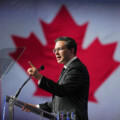
Geoff Russ: A future Conservative government must fight the culture war, not stand idly by
